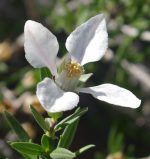 Also known as cliff fendlerbush, this deciduous shrub is native to the mountains of Texas, Arizona, New Mexico,Colorado, and Utah where it grows on dry rocky slopes, cliffs, mesas, and in canyons and deserts. It is a member of the hydrangea family, Hydrangeaceae, that also includes true mock-orange and Deutzia. Plants grow 3 to 9′ tall and are intricately branched with gray-brown often exfoliating bark and thick light green leaves that are eliptical to oblong, up to 1.25″ long, and twisted. In mid-spring, solitary or clusters of up to 3 pink buds open at the ends of short branches to 1.5″ wide flowers that have 4 purplish sepals and 4 narrow creamy-white petals that are clawed at the base. False mock-orange thrives in hot dry climates and is an excellent choice for xeriscape or a border in the hottest part of the garden. The genus name, Fendlera, honors August Fendler (1813-1883) German plant collector in North and Central America. Specific epithet, rupicola, comes from the Latin words rupes meaning cliff and colo meaning inhabit and refers to the native habitat of the plant. Type: Flowering deciduous shrub
Also known as cliff fendlerbush, this deciduous shrub is native to the mountains of Texas, Arizona, New Mexico,Colorado, and Utah where it grows on dry rocky slopes, cliffs, mesas, and in canyons and deserts. It is a member of the hydrangea family, Hydrangeaceae, that also includes true mock-orange and Deutzia. Plants grow 3 to 9′ tall and are intricately branched with gray-brown often exfoliating bark and thick light green leaves that are eliptical to oblong, up to 1.25″ long, and twisted. In mid-spring, solitary or clusters of up to 3 pink buds open at the ends of short branches to 1.5″ wide flowers that have 4 purplish sepals and 4 narrow creamy-white petals that are clawed at the base. False mock-orange thrives in hot dry climates and is an excellent choice for xeriscape or a border in the hottest part of the garden. The genus name, Fendlera, honors August Fendler (1813-1883) German plant collector in North and Central America. Specific epithet, rupicola, comes from the Latin words rupes meaning cliff and colo meaning inhabit and refers to the native habitat of the plant. Type: Flowering deciduous shrub
Outstanding Feature: Flowers
Form: Narrow, upright
Growth Rate: Moderate
Bloom: White 4 petaled flowers in mid-spring
Size: 3-9′ H
Light:Full sun
Soil: Average, dry, well-drained
Hardiness: Zones 6-10
Care: Prune back by no more than 1/3 after flowering every 2-3 years to shape.
Pests and Diseases: None of significance
Propagation: Seed, cuttings
Photo Credit:Wikimedia Commons